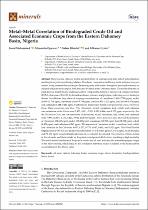Metal–metal correlation of biodegraded crude oil and associated economic crops from the Eastern Dahomey Basin, Nigeria
| dc.contributor.author | Mohammed, Saeed | |
| dc.contributor.author | Opuwari, Mimonitu | |
| dc.contributor.author | Titinchi, Salam | |
| dc.date.accessioned | 2022-09-21T09:37:03Z | |
| dc.date.available | 2022-09-21T09:37:03Z | |
| dc.date.issued | 2022 | |
| dc.identifier.citation | Mohammed, S. et al. (2022). Metal–metal correlation of biodegraded crude oil and associated economic crops from the eastern Dahomey Basin, Nigeria. Minerals, 12(8), 960. https://doi.org/10.3390/min12080960 | en_US |
| dc.identifier.issn | 2075-163X | |
| dc.identifier.uri | https://doi.org/10.3390/min12080960 | |
| dc.identifier.uri | http://hdl.handle.net/10566/7939 | |
| dc.description.abstract | The presence of heavy metals in plants from oil sand deposits may reflect mineralization resulting from petroleum biodegradation. Petroleum composition and heavy metal analyses were performed using thermal desorption gas chromatography and atomic absorption spectrophotometry on oil sand and plant root samples from the same localities in the Dahomey Basin. The results from the oil sand showed mainly heavy-end hydrocarbon components, humps of unresolved complex mixtures (UCM), absences of C6-C12 hydrocarbon chains, pristane, and phytane, indicating severe biodegradation. In addition, they showed varying concentrations of vanadium (2.699–7.708 ppm), nickel (4.005–11.716 ppm), chromium (1.686–5.733 ppm), cobalt (0.953–3.223 ppm), lead (0.649–0.978 ppm), and cadmium (0.188–0.461 ppm). Furthermore, these heavy metals were present in Citrus, Theobroma Cacao, Elaeis guineensis, and Cola. | en_US |
| dc.language.iso | en | en_US |
| dc.publisher | MDPI | en_US |
| dc.subject | Oil sand | en_US |
| dc.subject | Economic crops | en_US |
| dc.subject | Biodegradation | en_US |
| dc.subject | Nigeria | en_US |
| dc.subject | Petroleum system | en_US |
| dc.title | Metal–metal correlation of biodegraded crude oil and associated economic crops from the Eastern Dahomey Basin, Nigeria | en_US |
| dc.type | Article | en_US |

